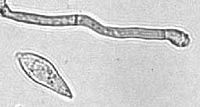
Photo from wikipedia
Rice blast, caused by the fungal pathogen Magnaporthe oryzae, is one of the most devastating diseases in rice (Oryza sativa L.). Plant annexins are calcium- and lipid-binding proteins that have… Click to show full abstract
Rice blast, caused by the fungal pathogen Magnaporthe oryzae, is one of the most devastating diseases in rice (Oryza sativa L.). Plant annexins are calcium- and lipid-binding proteins that have multiple functions; however, the biological roles of annexins in plant disease resistance remain unknown. Here, we report a rice annexin gene, OsANN1 (Rice annexin 1), that was induced by M. oryzae infection and negatively regulated blast disease resistance in rice. By yeast two-hybrid screening, we found that OsANN1 interacted with a cytochrome P450 monooxygenase, HAN1 ("HAN" termed "chilling" in Chinese), which has been reported to catalyze the conversion of biologically active jasmonoyl-L-isoleucine (JA-Ile) to the inactive form 12-hydroxy-JA-Ile (12OH-JA-Ile). Pathogen inoculation assays revealed that HAN1 was also a negative regulator in rice blast resistance. Genetic evidence showed that OsANN1 acts upstream of HAN1. OsANN1 stabilizes HAN1 in planta, resulting in the inactivation of the endogenous biologically active JA-Ile. Taken together, our study unravels a mechanism where an OsANN1-HAN1 module impairs blast disease resistance via inactivating biologically active JA-Ile and JA signaling in rice.
Journal Title: Plant physiology
Year Published: 2023
Link to full text (if available)
Share on Social Media: Sign Up to like & get
recommendations!